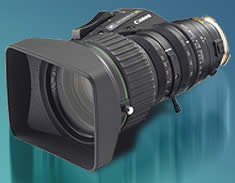Canon YJ 20x8.5B Series SDTV Pro-Video Len
Canon Updated: 2007-06-18The YJ20x8.5B is a long zoom portable 2/3-inch lens offered by Canon to support a broad diversity of professional, business and industrial production applications. It is the latest member of a family of portable Pro-Video lenses that collectively offer an affordable broad range of creative options.
The YJ20x8.5B IRS utilized advanced optical technologies and powerful computer-aided design techniques to produce a high-performing lens in an impressive 3.06lb package, a full 9% lighter than its predecessor, the YJ19x9B IRS, meanwhile the KRS version is 2.58 lbs, a full 11% lighter than its predecessor, the YJ19x9B KRS. It uses an internal focus system. It is a design directly responding to the expressed creative desires of a broad cross-section of producers for a versatile acquisition system.
ABOUT THIS LENS
The YJ20x8.5B represents an excellent compromise between the demands for high sensitivity (maximum relative aperture of f 1.8) and mobility in a lightweight handheld camera system that can address a wide diversity of corporate, business & industrial, and some broadcast applications
The YJ20x8.5B Series offers the widest focal length (8.5mm), highest zoom ratio (20x) of any lens in its class as well as the fastest servo zoom speed (1.2 seconds, end to end). In addition, the lens offers a generous horizontal field of view of 58.8 degrees. The optical optimization strategies achieved an excellent MTF profile over the entire image plane, minimization of chromatic aberrations, and maximization of image contrast. Contrast was extended by superb control of black reproduction - with optical and mechanical design innovations that substantially reduced flare, veiling glare, and any internal reflections.
The YJ20x8.5B Series also features an exclusive ergonomically designed drive unit. The drive unit will not only fit into the palm of your hand more comfortably, since it is smaller, it improves the feeling of unity between the drive unit and the lens. The drive unit, featuring a grip support and ribbed surface, is tilted at an ideal angle in order to achieve a better balance and to provide more comfort to the operator.
YJ20x8.5 KRS/IRS
Related Manuals
Canon YJ 19x9B Series SDTV Pro-Video Len
Canon KH 19x6.7 KTS Remote Control Len
Canon NU-700N Len
Canon YJ 13x6B Series SDTV Pro-Video Len
Canon Canobeam DT-150 HD Len
Canon YH 19x6.7 Series SDTV Pro-Video Len
Canon Canobeam DT-110 TYPE SFP
Canon YH12x4.8 Series SDTV Pro-Video Len
Canon DT-120 TYPE SFP Canobeam
Canon YH16x7 KRS SDTV Pro-Video Len
Canon HJ21x7.5B KLL-SC HD-EC Lens
Canon HJ11x4.7B KLL-SC HD-EC Len
